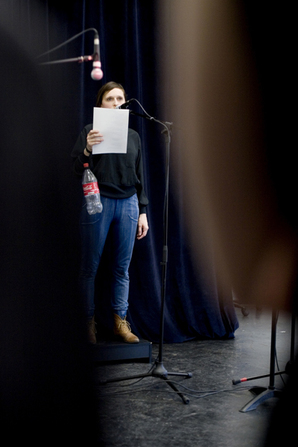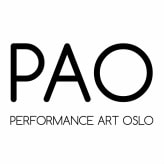Interview with Justyna Scheuring
 BREAD AND RADIATOR
BREAD AND RADIATOR
22. 10. 2014
Q: Why / when / how did you start to work with performance, what is your background, how did you arrive at doing performance?
I started creating performative work shortly after I finished my MA in Fine Arts in Poznan. Before performance, I was mainly creating installations, photography and objects and before that painting. I was also writing poetry. I started performing by reading my poetry within specially designed installations which were transforming into a new state of presence- holding the changes I made in the space and with the objects in it just through my very minimalistic gestures and words during the performances. At first, performing appeared unexpectedly, a bit from necessity due to the impact of an overwhelming influence and a subsequent need to reconfigure everything I had learnt about my world till then. This resulted from the sudden death of my brother in a car accident just 4 months after my father had passed away. Through performance I was trying to cross over my fears, expand my boundaries, incorporate and understand somehow who I was after everything that had happened. The live factor of the work became very important, bringing that intensity of emotions which comes from contact with the audience and also the learning process that comes from understanding one's own performative presence. In addition, performance was the most immediate medium to work with in dealing with the change and transformation that I so much needed to find a new language for. I was working with transforming meanings of relationships, presence, objects and bodies in relation to each other as well as the space the performance was taking place in. I still develop these ideas. Later on, I also started creating performative events, which take place without involving my performative presence. They are situations, which unravel according to a set of rules designed by me and are a frame for reactions, relations and interactions appearing between the people participating – the audience.
Q: What is your process like when you make a performance, from idea to actual work?
I gather moments, images in my head and sentences that are striking to me somehow. When I use objects I want them to create new meanings without losing their original meaning. I like questioning function in relation to presence, looking for ways to extend the possibilities of presence- which extend the possibilities of communication. Creating a performance is to me a process of impacting and playing with the meanings of things towards creating a parallel reality- which is absolutely connected with the one we think we commonly share. I work with pictures, emotions- deconstructing my thoughts while removing the intellectual understanding from the emotional content of the piece. Usually I look for a way to relate myself to a place as a starting point; I want to mark it with my presence, my energy and influence. I am interested in the avoidance of influence, a resistance as well as openness and interaction. I somehow gather and strip off towards the most minimalist outcome, searching for ways to make the objects, presence, gestures and movements interconnected without them loosing their autonomy and separateness. I’m curious for new relationships to appear in that process.
Q: Can you tell about your latest project?
Recently I created a performative event called “I don’t participate, but I love you”. The Centre of Contemporary Art, CSW Znaki Czasu in Torun in Poland produced it. The event was based on a meeting between two groups of people. One group came for a pop-up dinner in the gallery, the other group for a lecture on “Sexuality in Buddhist culture (tantric yoga)” by Dr Katarzyna Lewandowska. Neither group expected to share the room with another event. Though both events happened separately, the abnormality of the overlapping realities generated a space of interaction and provoked alot of emotional responses, leaving people with many reflections emerging from the confusion as well as the reactions and relations that appeared in-between the groups and within the space of the experiment.
Q: What role does performance art have in your life / artistic praxis. Do you also work within other fields, like installation, sculpture, drawing, other expressions. How do they influence / inform each other?
I create drawings, photography, installations, video, performative events – they all feed from each other and mix in my creative outcomes.
<< Back
Q: Why / when / how did you start to work with performance, what is your background, how did you arrive at doing performance?
I started creating performative work shortly after I finished my MA in Fine Arts in Poznan. Before performance, I was mainly creating installations, photography and objects and before that painting. I was also writing poetry. I started performing by reading my poetry within specially designed installations which were transforming into a new state of presence- holding the changes I made in the space and with the objects in it just through my very minimalistic gestures and words during the performances. At first, performing appeared unexpectedly, a bit from necessity due to the impact of an overwhelming influence and a subsequent need to reconfigure everything I had learnt about my world till then. This resulted from the sudden death of my brother in a car accident just 4 months after my father had passed away. Through performance I was trying to cross over my fears, expand my boundaries, incorporate and understand somehow who I was after everything that had happened. The live factor of the work became very important, bringing that intensity of emotions which comes from contact with the audience and also the learning process that comes from understanding one's own performative presence. In addition, performance was the most immediate medium to work with in dealing with the change and transformation that I so much needed to find a new language for. I was working with transforming meanings of relationships, presence, objects and bodies in relation to each other as well as the space the performance was taking place in. I still develop these ideas. Later on, I also started creating performative events, which take place without involving my performative presence. They are situations, which unravel according to a set of rules designed by me and are a frame for reactions, relations and interactions appearing between the people participating – the audience.
Q: What is your process like when you make a performance, from idea to actual work?
I gather moments, images in my head and sentences that are striking to me somehow. When I use objects I want them to create new meanings without losing their original meaning. I like questioning function in relation to presence, looking for ways to extend the possibilities of presence- which extend the possibilities of communication. Creating a performance is to me a process of impacting and playing with the meanings of things towards creating a parallel reality- which is absolutely connected with the one we think we commonly share. I work with pictures, emotions- deconstructing my thoughts while removing the intellectual understanding from the emotional content of the piece. Usually I look for a way to relate myself to a place as a starting point; I want to mark it with my presence, my energy and influence. I am interested in the avoidance of influence, a resistance as well as openness and interaction. I somehow gather and strip off towards the most minimalist outcome, searching for ways to make the objects, presence, gestures and movements interconnected without them loosing their autonomy and separateness. I’m curious for new relationships to appear in that process.
Q: Can you tell about your latest project?
Recently I created a performative event called “I don’t participate, but I love you”. The Centre of Contemporary Art, CSW Znaki Czasu in Torun in Poland produced it. The event was based on a meeting between two groups of people. One group came for a pop-up dinner in the gallery, the other group for a lecture on “Sexuality in Buddhist culture (tantric yoga)” by Dr Katarzyna Lewandowska. Neither group expected to share the room with another event. Though both events happened separately, the abnormality of the overlapping realities generated a space of interaction and provoked alot of emotional responses, leaving people with many reflections emerging from the confusion as well as the reactions and relations that appeared in-between the groups and within the space of the experiment.
Q: What role does performance art have in your life / artistic praxis. Do you also work within other fields, like installation, sculpture, drawing, other expressions. How do they influence / inform each other?
I create drawings, photography, installations, video, performative events – they all feed from each other and mix in my creative outcomes.
<< Back
